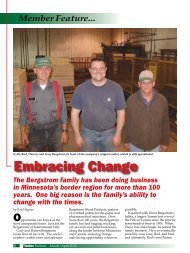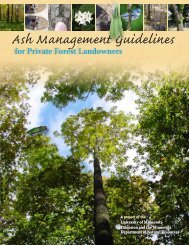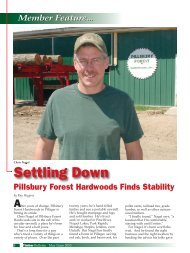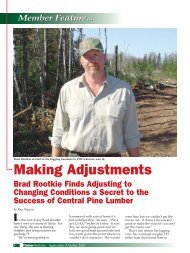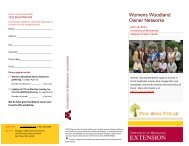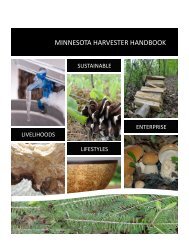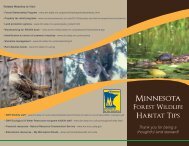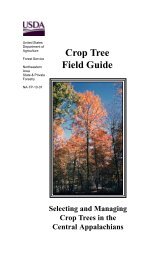Ash Management Guide for Private Forest Landowners
Ash Management Guide for Private Forest Landowners
Ash Management Guide for Private Forest Landowners
Create successful ePaper yourself
Turn your PDF publications into a flip-book with our unique Google optimized e-Paper software.
Chapter 5The Native PlantCommunitiesWet <strong>Forest</strong> SystemSurvey Recommendations: Wet <strong>Forest</strong>• If site does not have natural drainage, tree loss is likely to increase watertable depth.• Fire danger will increase when ash sites are replaced with grasses orcattails especially if the late summer or autumn is dry; fire intensity willincrease.Harvesting Wet <strong>Forest</strong> sites is very sensitive and extreme care should betaken when considering such an activity. Harvest when ground is frozen ordry. Clearcutting is not recommended. However several experts commentedthat strip or patch cuts may be appropriate especially when dealing withstands mixed with conifers.Use harvesting methods appropriate to allow <strong>for</strong> desired regeneration.Consider ash phloem reduction thinnings in conjunction with a sound regenerationplan and when EAB is known within 15 miles of a site. Accordingto one silviculture expert, “Use what works. You still have to deal with highwater tables, EAB or not.” Expect increasing water tables after ash has diedor is harvested.Because of the degree of uncertainty, new silvicultural practices need to beexplored <strong>for</strong> Wet <strong>Forest</strong> stands because of EAB. According to one expertpanelist in Ecosystem Classification System, “The concern is greatest in Wet<strong>Forest</strong>s where black ash is dominant. The collapse of a local, dominant populationwill leave considerable niche-space open <strong>for</strong> other plants. Un<strong>for</strong>tunately,this will not always be trees. Only white cedar is similarly adapted to wet <strong>for</strong>estsites and regeneration of cedar has been nearly non-existent due to deer depredationand adequate safe sites <strong>for</strong> seedling germination and survival. In allother systems, there are other trees that can fill the niche void when ash die.”Regeneration strategies could include both natural colonization and planting.It was noted that regeneration in these stands can be tricky because of standhydrology, so attention to micro sites and persistence will be important.Recommended replacement trees, as ranked by the experts:Opposite page: Generaldecline in wetland black ashnear Cloquet, MinnesotaNorthern Wet <strong>Forest</strong>:(11 out of 21 species)• Tamarack• White cedar• American elm (disease resistant)• Black spruce• Balsam poplar• Yellow birch• Balsam fir• Red maple• Quaking aspen• <strong>Ash</strong> (<strong>for</strong> genetic material)• Silver mapleSouthern Wet <strong>Forest</strong>:(10 out of 21 species)• American elm (disease resistant)• Silver maple• Basswood• Red maple• Willow• Bur oak• Yellow birch• <strong>Ash</strong> (<strong>for</strong> genetic material)• Box elder• Red elm36Steven Katovich, USDA <strong>Forest</strong> Service, Bugwood.org



